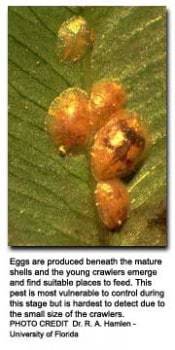Your cart is currently empty!
If you’re a plant owner, then chances are that you’ve experienced sticky plants and sticky residue on plant leaves at some point. There are many causes for wet or sticky plants, and today we’re going to talk about the most common ones and how to handle a plant with sticky leaves.
Table of contents
Sticky Plant Video
Cause of Sticky Residue on House Plant Leaves
The cause of the sticky leaf is usually scale insects on the plant. Scale insects feed and suck sap (the juices) out of houseplants.
Sticky Honeydew
The sticky residue on plant leaves and floor is what they secrete and is referred to as sticky honeydew. Too often people only look at the top leaves. Check plants by looking at the underside of the leaves and on the stems for slight bumps of tan, black or brown color with a waxy coating. You’ll find infested plants with scale insects or cottony masses of mealybugs hiding in out of the way places and out of sight where they can be left alone.
Sticky Leaves Treatment – Controlling Scale
Generally controlling scale insects isn’t a big problem. Scale “breathes” through their “armor.” The easiest way to kill the scale is by suffocation. There are several natural methods to control or get rid of the scale insects on plants indoors.
In the early stages of a light infestation:
- Mix 1 teaspoon of DAWN dish detergent into 1 quart of warm water
- Dip a cotton swab into the dish detergent / warm water mixture
- Wipe the area down completely
For large infestations, place the mixture into a spray bottle, spray the entire plant with the mixture and coat the infested areas completely. The dish detergent “clogs” or disrupts the plant scales ability to breathe. Other additions to the spray mixture include:
- A good insecticidal soap solution. The most popular plant soap goes by the name “Safer Soap” and works well if the infestation of scale isn’t extensive.
- Another “safe option” is to try Neem oil spray for plants. Neem oil is a great overall natural product which can also take control of spider mites and even fleas on pets.
- Adding a safe horticultural oil will do the trick. A word or warning – When applying any chemical, indoors or outdoors, do it carefully and follow the label directions exactly.
Before attempting to handle the pest issue, check with your local nursery or garden center – and remember… follow the label.
NOTE: On indoor plants, I would use neem oil or insecticidal soap. Horticultural oil is better on outdoor plants. Outdoors, the sticky residue is usually accompanied by sooty mold. As mentioned above horticultural oil, neem oil and insecticidal soap can all be used outdoors.
However, do not apply when temperatures are over 85 degrees Fahrenheit and beware these controls will also kill natural predators.
Systemic Control

Pest control with a spray indoors, especially in public areas, adds an additional risk. Many interior plant-scaping companies control plant scale and other pest problems with systemic insecticide chemicals.
Systemic work through the root system. The chemical for control is normally applied to the soil or buried in the soil where the plant absorbs the chemical through its root system and distributes the chemical throughout the plant. At scale, mealy bugs, spider mites, and other pests feast on sucking the plant’s juices out they take the chemical into their bodies which kills them. The systemic process take time – six to eight weeks is not uncommon. The systemic process is used primarily on large trees like ficus found in hotels and malls.
How to Clean Up Sticky Liquid Stuff
Cleaning the sticky stuff off furniture versus the floor can get a little tricky. You must first remember to pick up and clean up as much of the sugary sticky honeydew goo as you can.
Start with very warm water, apply to the area with a damp cloth or mop. Rinse frequently in hot, clean water. Some professionals recommend using Murphy’s Oil Soap and others rubbing alcohol and swabbing the area with a soft cloth. Make sure you test your cleaning potion on an “inconspicuous area” before you start pouring it on. You can discolor the material or strip off the furniture finish.
For good plant health, the most important thing to remember is maintenance – once you have control, maintain it by regular scouting of your plants for pests and plant diseases. Growers are always on the lookout for ants. Ants are great farmers and farm the scale and aphids for the honeydew they produce. Finding potential problems early helps prevent really big problems you’ll have to deal with later, not to mention the sticky floors and furniture.
Related
Share with Family and Friends
Featured Authors
Visit a Botanical Garden For Unique Experiences.
Comments
Logging in to comment gives you more features, but it is not required.













[…] the residue may not solve the issue, as it can be a sign of a larger infestation. Understanding the root cause of the problem is crucial in preventing future occurrences and maintaining a clean, bug-free living […]